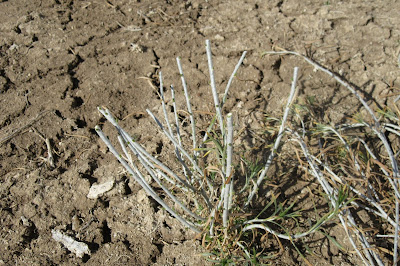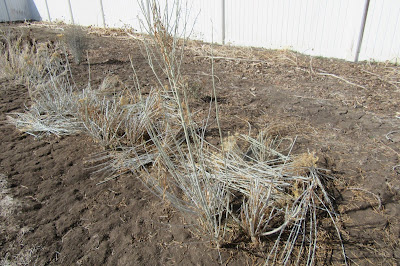 |
| Rabbitbrush shrubs need spring pruning. |
Spring
is almost here. The weather in Mother Nature’s Montrose Garden fluctuates
between the chilly 40’s and pleasantly warm, although most nights hover around
freezing. Some of the hardier shrubs are just beginning to leaf out. One group of native bush Sunflowers – the Rabbitbrushes
– are among the first. And that means it’s
time to prune them!
Several
species of Rabbitbrush are native to the Four Corners states. We’ll feature a
few as Plants of the Month in the coming year.
But in terms of pruning, the rules are pretty much the same. Rabbitbrushes are pruned in early spring,
when they begin to bud out – much like their cousins the Artemisias. And
they are pruned quite substantially; also like some of the Artemisias.
 |
| Budbreak in Rabbitbush |
In
the wilds, bush Sunflowers like the Rabbitbrushes provide important winter
browse for large animals like deer and elk, as well as smaller mammals (rabbits,
ground squirrels, pocket gophers, etc.). By late winter, plants are often severely eaten
down by the wildlife. And, since The Rabbitbrushes and their native ‘pruners’
evolved together, Rabbitbrushes have developed the ability to grow back
vigorously each spring.
 |
| Begin pruning Rabbitbrush the year after planting. |
In
fact, many native bush Sunflowers need a good pruning each spring. If
they don’t get it, plants become woody, leggy – in short, less attractive than
they should be. And pruning needs to begin in the first year after planting to
keep a Rabbitbrush shrub full and lush (as they are in the wilds).
 |
| Rabbitbrush in early spring. Note green stems and sprouting buds. |
Unlike some
shrubs, Rabbitbrushes retain the ability to sprout from older wood. As shown
above, even branches with a diameter of an inch or so are green; and buds can
be seen below the cut. This means you can prune a Rabbitbrush branch
quite hard, as long as you leave at least four buds below the cut.
 |
| Rabbitbrush before spring pruning. |
Above
is a Rabbitbrush before pruning. The
shrub was left unpruned over the winter (you can still see remnants of flowers
and old leaves). In colder climates (we’re
USDA Zone 6), old growth is left on the plants to protect them from winter
chill.
 |
| Partially pruned Rabbitbrush. |
To
give you an idea of our recommended pruning strategy, the picture above shows a
plant that is half pruned. You can see
that quite a bit of mass – up to two-thirds of the branch length – can be
removed, as long as there are heathy buds beneath. The photo below shows a fully pruned bush.
 |
| Fully pruning Rabbitbrush. |
At
this point we leave the prunings around the plant to protect it and conserve
soil moisture. When the trimmings are
dry, we’ll cut them into smaller pieces and use them as mulch. And that’s pretty much all there is to say
about pruning Rabbitbrushes.
We welcome your comments (below). You can also send your questions to: monaturesmontrosegarden@gmail.com


It is so nice to see your article, thanks for posting! I live in zone 7a, Northern Nevada, and we have lots of rabbit brush. I’m all for tending the native plants on our property, they’re established and need no water, although we have not had enough grazing for natural pruning to occur, and for fire safety, I wanted to know if you could prune out the dead wood under growth. I’ve been experimenting and so glad that pruning these is an option. The silver sage I pruned dead wood off of last year bushed out first and the rabbit brush followed. I hard pruned the dead wood and am glad to see new leaves everywhere!
ReplyDelete